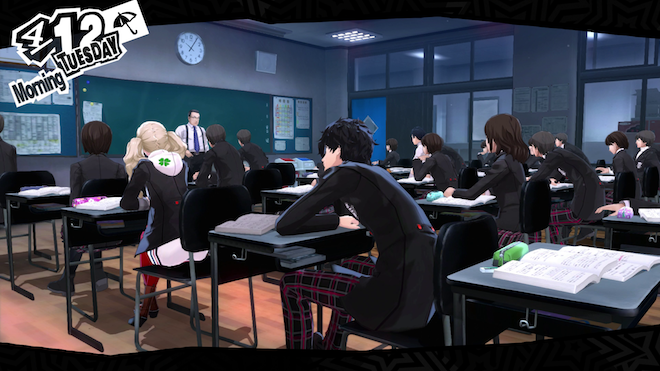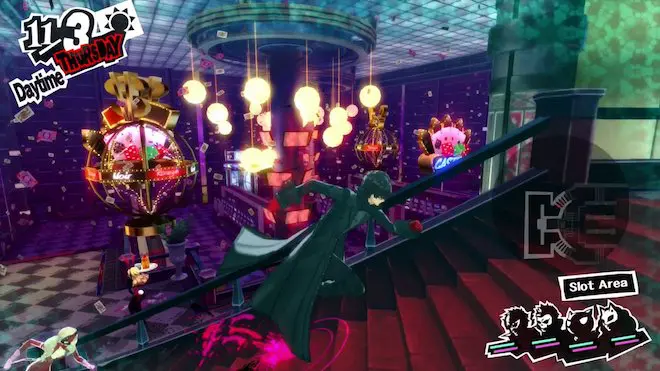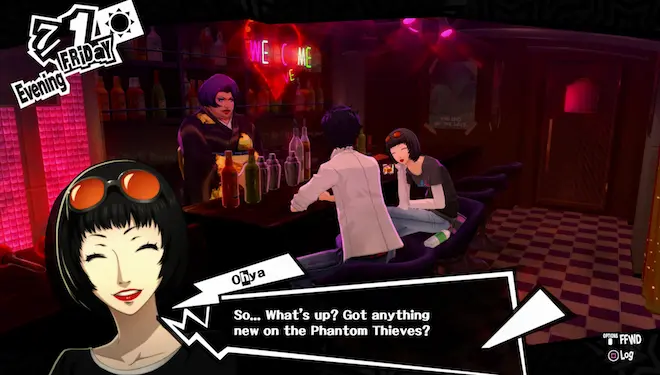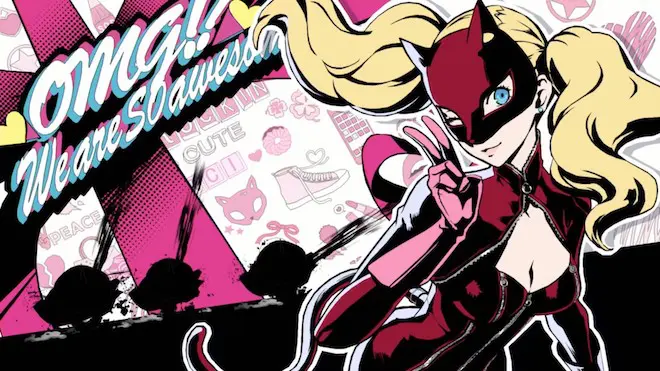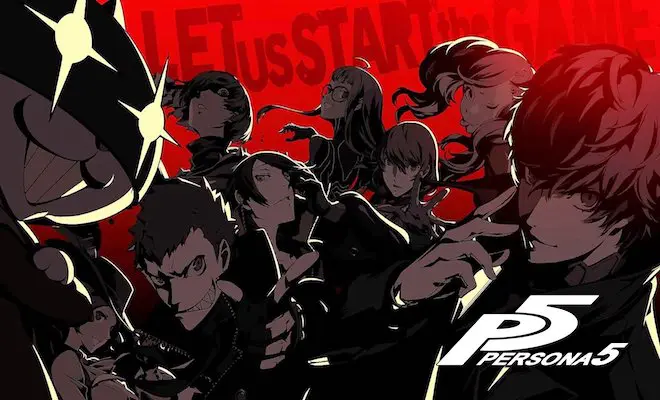I have a secret: I absolutely hated Persona 5 the first time I played it. For the first 90 minutes, all I did was read screen after screen, fought one battle, registered in a new school, and went to sleep in a bed — twice. In almost two hours. In fact, I even complained to my fellow critics that I just didn’t get the high praise that was being levied at this game. I’d played a little bit of the last few Persona games (but never to completion), and even reviewed Persona 4: Dancing All Night, which I enjoyed, but I thought that maybe I was missing something; that maybe JRPGs had finally advanced past a level that I could enjoy them.
And then I played it again.
After my character woke up that second time, the game seemed to also wake up. And it woke up something in me. And by the time I hit around the two hour mark, I was not only hooked deeply into Persona 5, I was in the first steps of a game that has completely ruled my life for the last month, and for well over 100 hours. I’m still sitting here thinking about the game, its themes, its incredible music, and the characters and situations. Persona 5 sucked me in, and now I’m calling it one of the best JRPGs I’ve ever played, and is up there with the new Zelda as the best games of the year.
Persona 5 is the story of a player-named teenaged protagonist, who tried to do a good deed and was chewed up and spit out by a system of corruption and some shady adults. Now, a “criminal” with a record and on probation, this kid has to go to a new school and start over, with the stigma of his past haunting him every step of the way. At his new school, he meets Ann and Ryuji, a gorgeous model with a secret, and a social outcast, respectively. Each has been affected by a shady PE instructor/renowned volleyball coach at the school named Kamoshida, and as the hero gets accustomed to his new school, he is drawn into the conflict with this sexually deviant teacher.
The three friends realize that they have the mysterious ability to warp to the cognitive metaverse, a second dimension that runs parallel to ours, and can change people’s hearts by taking their treasures, the one thing they value above all else. Bad people in the metaverse set themselves up is huge palaces, and our heroes, dubbed The Phantom Thieves, must infiltrate the palaces and steal the treasures to change the hearts of the bad people in the real world. There is way more to explain, but for the purpose of whatever kind of brevity I can do in this review, that’s all you really need to know.
The Phantom Thieves begin to grow in popularity, and in teammates, as they take on bad person after bad person, exploring and infiltrating palace after palace. But there is a much bigger threat at play here, and this group of heroes has garnered the attention of some very bad, and very powerful people, and what started out as a way to get justice for the innocent turns into a very fight for not just the students at Shujin Academy, but for the people of Japan, and the world as a whole.
Persona 5 is so much more that a contemporary-based fantasy RPG. Alongside the exploration of the metaverse and its palaces, the hero and his friends also have to live their lives in the real world. Persona 5 is broken down into the day-to-day of a full calendar year. And you will play each day, from April to the following March, living each day and whatever that day brings. Some days might just be a conversation or two then your cat, Morgana, will tell you to go bed. Other days are spent juggling activities. This means classes (with exams!), part-time jobs, the building of relationships, both friendly and romantic — some even taboo — and all the mundane little things that make up life.
Everything that you do in Persona 5 seems to have a bearing on something. Players can build up social skills, like charm, kindness, and guts, and every relationship adds a new confidant to the mix, and with that comes new skills and powers to be used in both worlds. It pays to work a shift at the noodle shop for some extra cash (and some skill points), use your downtime to read a book, watch a DVD, or play a video game, and learning to juggle all of this while playing the role of Phantom Thief in the other world is part of the draw.
Life in the metaverse is drastically different. Each of the characters has the ability to call upon a Persona, which grants them powers to evil battle shadows and palace rulers. The main character can collect multiple Personas and even craft new ones by executing old ones. This brings in a Pokemon-like element to Persona 5, as collecting them all is incredibly fun and rewarding. The Personas are all based on myths and legends, so some of the most powerful Personas are recognizable names, like Goemon, Captain Kidd, and even Robin Hood. Personas are also trained and gain new skills, which have to replace older skills as they level up. This gives the player yet another thing to juggle here.
Combat is turn-based, and each character in the four-person party has a variety of attacks, each mapped to its own button. Characters have the standard melee attack, a range attack, and they can cast spells with their Personas. The Personas have type strengths and weaknesses, and it almost becomes a puzzle trying to figure out what element does the most damage. If you use a power that an enemy is weak against, you can cripple it into the “hold up” stage of the battle, where you can negotiate for an item, money, or as it for its power. This is done in the form of questions that you must navigate correctly to win the shadow’s trust. Or, you can just call for an all out attack, and all member of the party will light up the enemy, usually for a quick end to the battle. If you deal enough damage, the shadow may even beg for its life. All of this helps keep the combat uniquely fresh, even 70-80 hours into the game.
When not taking on palaces and their rulers, the Phantom Thieves can go into a region of the metaverse called Mementos, and seek to change the hearts of lesser bad guys. This is a great way to grind for XP and to collect missed Personas and treasure and items. Mementos, which is the metaverse version of the Japanese subway system, is vast and ever growing, as each time a palace falls, and new area opens up. A real world ally, Mishimi, runs the Phantom Thieves website, and he scours the forums to find people that need a change of heart. The hero will also stumble across friends and acquaintances that need some help with a bully at work or school, and that is handled in Mementos.
As said, relationships play a huge role in Persona 5, and fostering and grooming them has incredible rewards. Collecting confidants and getting them maxed out is a must for success, but juggling the time to go hang out with each person — and each person has a matter they are dealing with that has to be solved, kind of like a side-story — becomes something else the player has to contend with between all the other facets of life present in Persona 5.
The player has the option to romance nearly all of the opposite sex characters (same sex relationships were omitted here, much to the chagrin of a sect of players), and he can even have multiple romances, but that can turn into a mess — as you might imagine. Personally, I started a relationship with my older teacher — taboo in almost every culture — and I think that was part of the draw for me. There were characters I liked better (the voice acting across the board is fantastic and you actually care for these people), but something about the teacher and her troubles made me feel like a true hero to help her out. BTW, she and I are still together. I’m a one woman guy in video games, too.

This is my teacher. Who is also my girlfriend. And my maid. She calls me master. Our relationship is…complicated.
As Persona 5’s story unfolds, it plays out much like a long-form piece of fiction, like a novel, or an entire Manga run. While it is deliciously Japanese in every way (honorifics, culture, going to school for six days a week, taking the train everywhere and dealing with enforced curfews — you are still a teenager here), there is just as much story in the subtext as in the main narrative, which gives it that epic novel feel. The game’s mastermind (writer/director/producer), Katsura Hashino, will introduce elements or characters early in the game that come into play later, all with a very connected feel. I’ve not seen this kind of wide-screen storytelling in a video game in, well, maybe ever. When this story ends, you actually feel like you have done something grand. There are characters that you’ve grown to know and love, and their situations and life obstacles became your situations and obstacles, and if done right, you overcame them all together. This is where Persona 5 really, and truly shines, and why it is unparalleled in console gaming.
The glue holding the gameplay and the epic storytelling together has to be the music. Composer Shoji Meguro has crafted a jazzy soundtrack that is phenomenal in almost every way. The songs all work in perfectly for every situation. When you acquire a new confidant, an ominous song plays, and after a few hours, when you hear that song, you know you are about to acquire something badass. The post battle fanfare (and the accompanying animations) are exquisite. I wish that I could have that fanfare play every time I did something in my real life. Publish a review, hear the fanfare. Clean out the my cat’s litter box, hear the fanfare. Get out of bed, hear the fanfare. It sure would make life better across the board. The Persona 5 soundtrack was a must-buy for me, without a second of regret. It’s that good.
The art direction in Persona 5 is another strongpoint. The character designs, costumes (both in the real world and in the metaverse) and various the Personas all have distinct coolness factor going for them. It’s not straight Manga style, nor is it completely Anime (animated cutscenes throughout the game will highlight this fact), but Shigenro Soejima’s character designs are unique all their own (and have been for the past few Persona games).
Ann Takamaki, a girl that is only one-quarter Japanese, has blue eyes and long blond hair pulled into pigtails. Ryuji is a Japanese teen who dyes his hair blonde and shrugs off the school uniform for printed T-shirts and rolled up pant legs. Makoto Naijima, the class president, is prim and proper in her attire and mannerisms, and Futaba Sakura is a withdrawn computer hacker, who always wears her headphones and an eclectic mix of clothes, depending on the time of year. Each character’s style helps solid them in the story, without going overboard. And outfits change with the seasons, which is a nice touch. The palaces and Mementos are twisted versions of locations in the game, and the cool art direction expands to make these places seem lived in, within the context of the game, of course. As a whole, Persona 5 just oozes coolness, from the gameplay, to the music and voice acting, to the top-shelf art direction and character design.
If Persona 5 had a downside, it comes solely from the way the game forces the player to move forward. By the first five hours, I was kind of tired of hearing my cat tell me it’s time to go to bed. And since this is such a grand tale, certain events occur or are revealed through conversation. There was a period in July, after exams, that I seemed to be on autopilot for a whole month of waking up, reading conversations, cat telling me to go bed; rinse and repeat. Over and over. In that time, I could have worked my job, played some games or watched some DVDs (since my freedom to act was taken for almost a month, I was hit hard with DVD late fees — luckily, they waved them, but still), or bettered myself instead of reading text box after text box, day after day. This actually happens a few times in the course of Persona 5’s story, but this was the first time that a whole month was taken for narrative, and it was kind of jarring and a little frustrating.
Persona 5 is one of those games that sneaks up on you. I knew what it was before starting it, and not even that knowledge, or past experiences in the Persona franchise, could have prepared me for what was to come. I fell in love with the story (as “out there” as it is) and the characters, and took ownership of the actions on-screen. This game has thrilled me over and over for more than a month, and when I’m not playing it, I’m thinking of playing it. It’s the kind of game that I want to restart and play again, without even thinking of the time investment needed, just so I can be a part of the Phantom Thieves again; so I can go shopping with Ann, or run laps around the school with Ryuji, or learn about art from Yusuke, work my job at the Crossroads bar, listening to people’s problems, or take my hot teacher out for date on a ferris wheel and give her expensive perfume as a gift. And none of those examples are based on combat or exploration. My yearning comes from the relationships I built with my in-game friends, the mundane activities that make up life, and that truly says it all. Persona 5 is a game that haunts the player, well after the final credit has rolled, and games like this are few and far between. I know I will be haunted for a very long time.
Persona 5 is available now for the Playstation 3 and Playstation 4. There are also various DLC additions already available, including costumes sets from previous Persona games, and the option to play the game with the original Japanese dub. Go to the Atlus website for more details. This review is based off a review code provided by Atlus.


